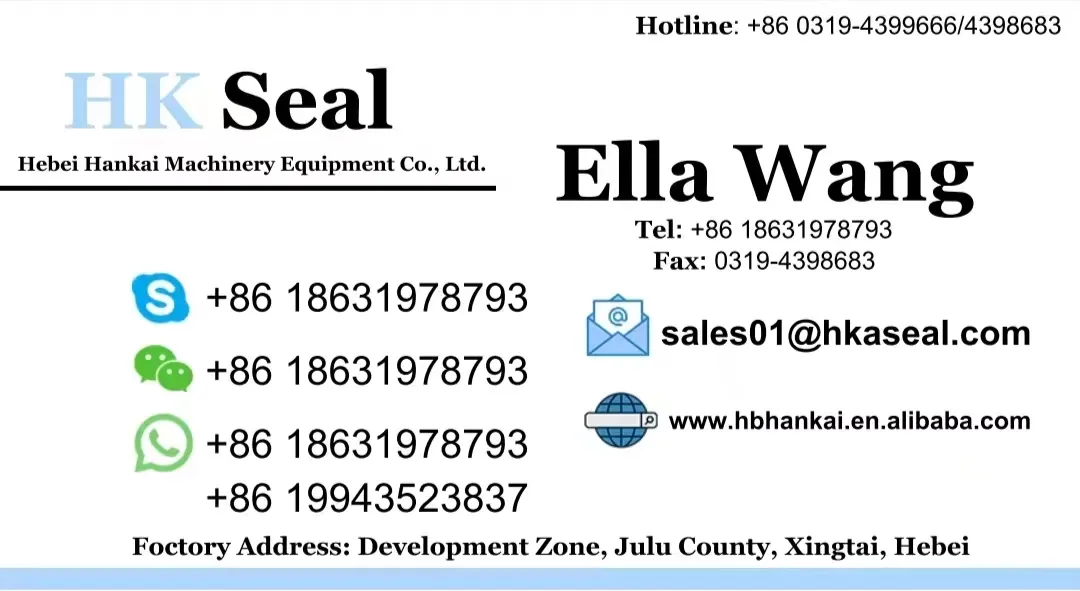Dec . 10, 2024 14:17 Back to list
hydraulic oil seal material
Understanding Hydraulic Oil Seal Materials
Hydraulic systems are integral to modern machinery and industrial applications, providing efficient power transfer and control. At the heart of these systems lie hydraulic oil seals, essential components that prevent fluid leakage, maintain pressure, and protect internal components from contaminants. The choice of materials for these seals is crucial for ensuring longevity, reliability, and overall system performance. In this article, we will explore the various materials used in hydraulic oil seals and their specific properties.
Common Materials for Hydraulic Oil Seals
1. Nitrile Rubber (NBR) Nitrile rubber, or Buna-N, is one of the most commonly used materials for hydraulic oil seals. Renowned for its excellent resistance to petroleum-based fluids, NBR performs well in a range of temperatures (from -40°C to +100°C). This versatility makes it a popular choice for many hydraulic applications. Additionally, it exhibits good mechanical properties and is relatively inexpensive to produce, making it widely available.
2. Fluoroelastomer (FKM) Fluoroelastomers, often referred to by the brand name Viton, are particularly well-suited for high-temperature applications and aggressive fluids. They can withstand extreme temperatures, up to 200°C or more, and provide superior chemical resistance compared to nitrile rubber. This makes FKM an excellent choice for hydraulic seals operating in harsh environments where exposure to chemicals and elevated temperatures is common.
3. Polyurethane (PU) Polyurethane is recognized for its high wear resistance and elasticity, making it an ideal material for dynamic sealing applications. Hydraulically actuated systems often rely on polyurethane seals due to their ability to maintain a tight seal under varying pressures and movements. However, polyurethane may not be suitable for all fluids, so careful consideration is necessary when selecting this material for specific hydraulic environments.
4. EPDM (Ethylene Propylene Diene Monomer) EPDM seals are well-regarded for their excellent resistance to water, steam, and a broad range of chemicals. While they perform well in applications involving water-based fluids, their compatibility with petroleum-based fluids is limited. EPDM is often used in applications that involve exposure to ozone or extreme weather conditions, making it suitable for outdoor hydraulic systems.
5. PTFE (Polytetrafluoroethylene) PTFE is known for its exceptional chemical resistance and thermal stability. Commonly recognized by the trademark name Teflon, PTFE seals are not as flexible as rubber seals but offer significant advantages in specific applications, such as in corrosive environments or where high temperatures are involved. Its low friction properties also make PTFE an ideal choice for reducing wear and energy loss in hydraulic systems.
hydraulic oil seal material

Factors Influencing Material Choice
When selecting the appropriate material for hydraulic oil seals, several critical factors come into play.
- Fluid Compatibility Different fluids interact uniquely with various materials, affecting seal performance
. It's essential to choose a seal material that resists chemical degradation from the hydraulic fluid in use.- Temperature Range Operating temperatures can vary significantly based on the application. Ensuring that the selected material can withstand these temperatures without compromising integrity is vital.
- Pressure Conditions The pressure of the hydraulic system will impact the seal's functionality. Materials must be able to maintain their shape and sealing capabilities under high pressure.
- Cost Considerations Budget constraints may influence material selection, but it’s important not to compromise on quality and reliability.
In conclusion, the choice of hydraulic oil seal material plays a fundamental role in the performance and reliability of hydraulic systems. By understanding the distinct properties and applications of various seal materials, engineers and technicians can better ensure the longevity and efficiency of hydraulic machinery.
-
TCN Oil Seal Metal Ring Reinforcement for Heavy Machinery
NewsJul.25,2025
-
Rotary Lip Seal Spring-Loaded Design for High-Speed Applications
NewsJul.25,2025
-
Hydraulic Cylinder Seals Polyurethane Material for High-Impact Jobs
NewsJul.25,2025
-
High Pressure Oil Seal Polyurethane Coating Wear Resistance
NewsJul.25,2025
-
Dust Proof Seal Double Lip Design for Construction Equipment
NewsJul.25,2025
-
Hub Seal Polyurethane Wear Resistance in Agricultural Vehicles
NewsJul.25,2025
-
The Trans-formative Journey of Wheel Hub Oil Seals
NewsJun.06,2025
Products categories
















